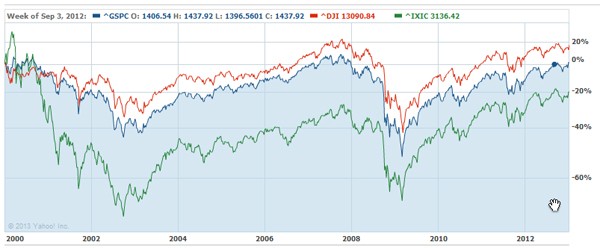Stock Indexes – FREE Stock Indexes information
Post on: 11 Апрель, 2015 No Comment

An understanding of the basic characteristics of the different kinds of stocks will be helpful in considering the information in this article. An investor’s most important tool is information: information about stock prices, movement in the market, and business trends. Without sound information, investment decisions are pure guesswork. The first place to look for information about any stock is the financial pages of a newspaper, and the best place to start is with the columns listing the current stock prices on one or more of the major organized exchanges. Figure 1 shows a typical listing for a stock traded on one of the major exchanges. The following list explains the information and what it means for prospective investors:
SAMPLE STOCK LISTING
- High and low. These are the highest and lowest prices paid for the stock during the previous fifty-two weeks. This item shows that the highest price paid for this stock during the previous period was $44 per share; the lowest price, $16 per share.
- Stock. Stocks are listed alphabetically by an abbreviated form of the corporate name, in this sample, JLJ.
- Dividend (Div). The rate of annual dividend is shown; it is generally an estimate based on the previous quarterly or semiannual payment. This item shows that JLJ is paying an annual dividend of $2.50 per share, or about 7 percent yield.
- Price/Earnings (P/E) ratio. This is the ratio of the market price of the stock to the annual earnings of the company per share of stock. It is an important indicator of corporate success and investor confidence and cannot be calculated from the information given here as other data are needed to do so.
- Shares traded. This is the number of shares sold for the day, expressed in hundreds. In the example shown, 3,300 shares of JLJ stock were traded. The figure does not include odd-lot sales. Note: If the number in this column is preceded by a z, it signifies the actual number of shares traded, not hundreds.
- High and low. These are the highest and lowest prices paid for JLJ stock during the trading session (that is, the business day). The highest price paid for JLJ stock was $35.25 per share; the lowest price, $34 per share.
- Closing price (Last). The final price of JLJ stock for the day. In this case, it was $35 per share.
- Change. The difference between the closing price of the stock for this session and the closing price for the previous close; yesterday’s closing price would have been $34.50 ($35.00 minus $0.50).
Understanding the details of a particular stock is basic to finding value in a stock market index which reflects a critical characteristic statistically determined about a group of stocks. What follows is a general introduction to such indexes.
USEFULNESS OF STOCK MARKET INDEXES
The expectations of future growth and profit are captured through computations that are called market indexes. Such indexes provide, in essence, summaries of expectations. There are indexes that cut across industries; there are indexes that deal with one industry only. Indexes include varying numbers of stocks. Additionally, indexes are based on a variety of assumptions about the factors that influence expectations. Factors that might be used in several indexes may be given different weights in each index. Many market indexes will, at times, provide the same, or similar, assessments. Nevertheless, there is considerable difference in the performance of indexes in the long run. The stocks, divisors, and weighting selected for an index lead to long-run difference.
SOME POPULAR STOCK MARKET INDEXES
There are thousands of stock market indexes. Much information is available through accessing Web sites of exchanges and other organizations, such as Dow Jones and Russell Group, that have developed indexes. Details of the assumptions and stocks included are readily provided in materials accessible at Web sites. Some stock exchanges provide custom-designed stock market indexes. There are such indexes in many countries. Some of the most popular U.S. indexes in (alphabetical order) are:
- American Stock Exchange (AMEX) composite index
- Dow Jones Industrial Average (DJIA) index
- NASDAQ composite index
- NASDAQ 100 index
- New York Stock Exchange (NYSE) composite index
- Russell 3000 value index
- Standard & Poor’s (S&P) 500 index
Three of the most widely quoted stock market indexes and the types of stocks they include are briefly discussed here.
Sample stock listing














